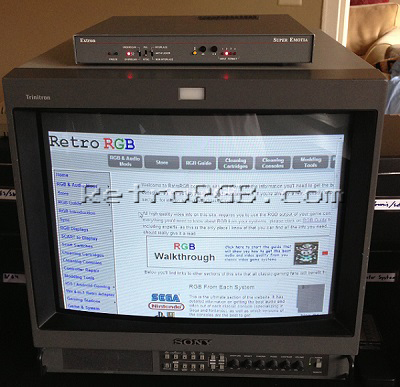AV:Extron Emotia: Difference between revisions
No edit summary |
m (Text replacement - "[.][ ][ ]" to ". ") |
||
| Line 1: | Line 1: | ||
[[File:VGAtoRGB01.jpg]] | [[File:VGAtoRGB01.jpg]] | ||
This page shows you how to display ''any'' 640x480 VGA source on your RGB monitor, utilizing an Extron Emotia (exact compatible models listed below). | This page shows you how to display ''any'' 640x480 VGA source on your RGB monitor, utilizing an Extron Emotia (exact compatible models listed below). There are other devices that are similar, but the Emotia is so easy to use that it stands out. Here's a quick rundown of how to use it: | ||
First, plug your VGA source into the Emotia and use BNC cables to go from the Emotia to your RGB monitor. | First, plug your VGA source into the Emotia and use BNC cables to go from the Emotia to your RGB monitor. Please note that it's a male VGA port, so you'll need to get the proper cable or gender changer, based on your VGA source. All the cables you need should be available via the links on your right, but please double check your VGA source before buying, just to be safe. <br>[[File:VGAtoRGB02.jpg]] | ||
Here's how one looks plugged in. | Here's how one looks plugged in. Notice there is a "monitor output" connection on the far left, so you can connect a VGA monitor as well. This is good if you need to experiment with different resolutions that your RGB monitor may not support. Also, there's an S-Video and Composite out, but you probably won't need those. Lastly, note the one black button between the VGA ports.<br> [[File:VGAtoRGB03.jpg]] | ||
Then, turn on your VGA device and set it to 640x480. | Then, turn on your VGA device and set it to 640x480. Some RGB monitors accept higher resolutions, but just start with that for now. | ||
If your picture looks weird, try pressing the black button in the rear of the unit between the two VGA connectors (that I mentioned above). | If your picture looks weird, try pressing the black button in the rear of the unit between the two VGA connectors (that I mentioned above). That should be all it needs to work. | ||
[[File:VGAtoRGB04.jpg]] | [[File:VGAtoRGB04.jpg]] | ||
===A note about 240p=== | ===A note about 240p=== | ||
When a 640x480 VGA device is passed through the Super Emotia, the signal is being converted to interlaced, making it 480i RGB. | When a 640x480 VGA device is passed through the Super Emotia, the signal is being converted to interlaced, making it 480i RGB. If you set the front switch to "Non-interlace", it will convert the signal from 480i to 240p (320x240 progressive scan). Most of the time, this may actually look _much_ better. This is especially true if you're making a Mame arcade machine, or playing emulators for older systems who's native resolution is 240p. For more information, please check out [240p.html my 240p page]! | ||
===Compatible Emotia's=== | ===Compatible Emotia's=== | ||
The only versions of the Emotia to feature 240p output are the Extron Emotia, the Emotia Plus, the Super Emotia and the Super Emotia GX. Other models like the Super Emotia II or Emotia Xtreme have dropped their 240p capability. | The only versions of the Emotia to feature 240p output are the Extron Emotia, the Emotia Plus, the Super Emotia and the Super Emotia GX. Other models like the Super Emotia II or Emotia Xtreme have dropped their 240p capability. | ||
Revision as of 05:26, 29 July 2022
This page shows you how to display any 640x480 VGA source on your RGB monitor, utilizing an Extron Emotia (exact compatible models listed below). There are other devices that are similar, but the Emotia is so easy to use that it stands out. Here's a quick rundown of how to use it:
First, plug your VGA source into the Emotia and use BNC cables to go from the Emotia to your RGB monitor. Please note that it's a male VGA port, so you'll need to get the proper cable or gender changer, based on your VGA source. All the cables you need should be available via the links on your right, but please double check your VGA source before buying, just to be safe. 
Here's how one looks plugged in. Notice there is a "monitor output" connection on the far left, so you can connect a VGA monitor as well. This is good if you need to experiment with different resolutions that your RGB monitor may not support. Also, there's an S-Video and Composite out, but you probably won't need those. Lastly, note the one black button between the VGA ports.

Then, turn on your VGA device and set it to 640x480. Some RGB monitors accept higher resolutions, but just start with that for now.
If your picture looks weird, try pressing the black button in the rear of the unit between the two VGA connectors (that I mentioned above). That should be all it needs to work.
A note about 240p
When a 640x480 VGA device is passed through the Super Emotia, the signal is being converted to interlaced, making it 480i RGB. If you set the front switch to "Non-interlace", it will convert the signal from 480i to 240p (320x240 progressive scan). Most of the time, this may actually look _much_ better. This is especially true if you're making a Mame arcade machine, or playing emulators for older systems who's native resolution is 240p. For more information, please check out [240p.html my 240p page]!
Compatible Emotia's
The only versions of the Emotia to feature 240p output are the Extron Emotia, the Emotia Plus, the Super Emotia and the Super Emotia GX. Other models like the Super Emotia II or Emotia Xtreme have dropped their 240p capability.

